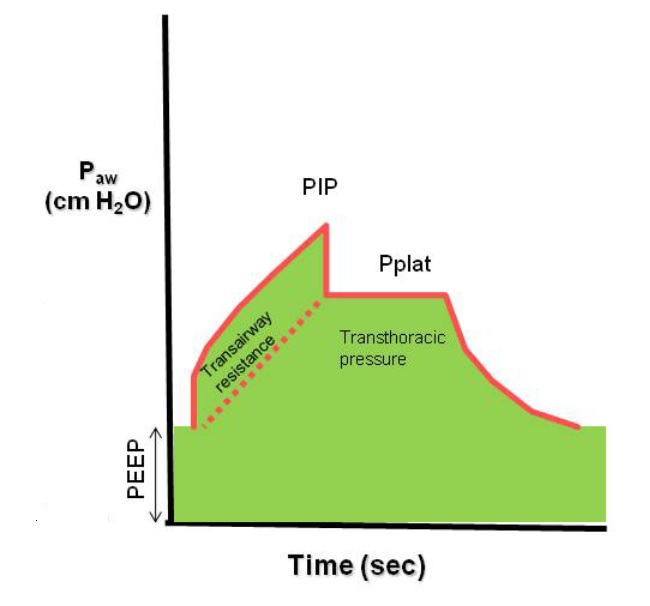Mechanical ventilation ventilator variables
|
Mechanical ventilation Microchapters |
|
Mechanical ventilation ventilator variables On the Web |
|---|
|
American Roentgen Ray Society Images of Mechanical ventilation ventilator variables |
|
Risk calculators and risk factors for Mechanical ventilation ventilator variables |
Editor-In-Chief: C. Michael Gibson, M.S., M.D. [1]; Associate Editor(s)-in-Chief: Syed Hassan A. Kazmi BSc, MD [2]
Overview
Ventilator variables modulate the oxygenation achieved. They can be adjusted according to the clinical condition of the patient and to achieve specific goals of management. The variables include fraction of inspired oxygen (FiO2), tidal volume (Vt), respiratory rate (f), positive end expiratory pressure (PEEP), inspiratory time, inspiratory flow rate, peak inspiratory pressure (PIP) and plateau pressure (Pplateau). Tailoring the ventilator settings can help achieve specific goals, for example, to improve oxygenation, option include increasing the FiO2 and PEEP and to improve ventilation, the tidal volume (Vt), inspiratory pressure and respiratory rate (f) may be increased (this follows the basic principle of minute ventilation = Tidal volume x respiratory rate).
Variables variables
The following are the various variables on a ventilator:[1][2][3][4]
FiO2
- Fraction of inspired air that is oxygen
Tidal volume (Vt)
- Volume of breath delivered
- Target should be lung protective: goal of less than equal to 6 cc/Kg
Repiratory rate (f)
- Rate is set by ventilator
- f may be lower than respiratory rate if breaths are patient triggered
Positive end expiratory pressure (PEEP)
- Positive pressure applied during exhalation via resistor in exhalation port
- Prevents alveolar collapse
- Decreases shunting
- Increases oxygenation via alveolar recruitment
- Improves compliance
- Allows severely obstructed patient to initiate breaths
- Cardiac effects include decreased preload by increased intrathoracic pressure and decreased venous return to the heart. Decreases afterload by decreasing cardiac transmural pressure
- Adjustable oxygen delivery
- Auto-PEEP or intrinsic PEEP is a phenomenon where there is inadequate exhalation time and the lungs are unable to completely empty before the next breath (breath stacking)
- Auto-PEEP will decrease the preload and may decrease cardiac output especially if patient is hypovolemic. It also increases work of breathing because patient must overcome auto-PEEP to trigger ventilator. It may be detected if end expiratory flow is not equal to zero before the next breath
- Auto-PEEP can be decreased by the following measures:
- Increase expiratory time
- Decrease respiratory rate
- Decrease tidal volume
- Manage bronchospasm and secretions
Inspiratory time
- Normally inspiratory to expiratory ratio (I:E) is 1:2
- Can be used to alter flow rate
- Used in pressure-control mode
Inspiratory flow rate
- Increased flow rate leads to decreased inspiratory time and increased expiratory time. Therefore, may improve ventilation in obstructive lung disease.
- May affect respiratory rate and bronchodilation/bronchoconstriction
Peak inspiratory pressure (PIP)
- Dynamic measurement during inspiration
- Set in pressure-targeted mode
- Determined by airway resistance and lung compliance
- Increased PIP without increased plateau pressure (Pplat) implies increased airway resistance (e.g. bronchospasm, plugging)
- Decreased PIP implies decreased airway resistance or air leak in the system
Plateau pressure (Pplat)
- Static measurement at the end of inspiration, when there is no flow.
- Determined by respiratory system compliance (airway resistance is not a factor since there is no flow)
- Increased Pplat implies decreased lung or chest wall compliance (e.g. pneumothorax, pulmonary edema, pneumonia, atelectasis). It may also be due to increased PEEP or auto-PEEP.
- Pplat < 30 cm H2O decreases barotrauma (decreased Vt, decreased PEEP or increased compliance for example secondary to diuresis)

References
- ↑ Mejhert M, Linder-Klingsell E, Edner M, Kahan T, Persson H (September 2002). "Ventilatory variables are strong prognostic markers in elderly patients with heart failure". Heart. 88 (3): 239–43. PMC 1767337. PMID 12181213.
- ↑ Huhle R, Pelosi P, de Abreu MG (March 2016). "Variable ventilation from bench to bedside". Crit Care. 20: 62. doi:10.1186/s13054-016-1216-6. PMC 4791785. PMID 26979175.
- ↑ Sassoon CS, Gruer SE (February 1995). "Characteristics of the ventilator pressure- and flow-trigger variables". Intensive Care Med. 21 (2): 159–68. PMID 7775698.
- ↑ Sassoon CS (September 1992). "Mechanical ventilator design and function: the trigger variable". Respir Care. 37 (9): 1056–69. PMID 10145700.